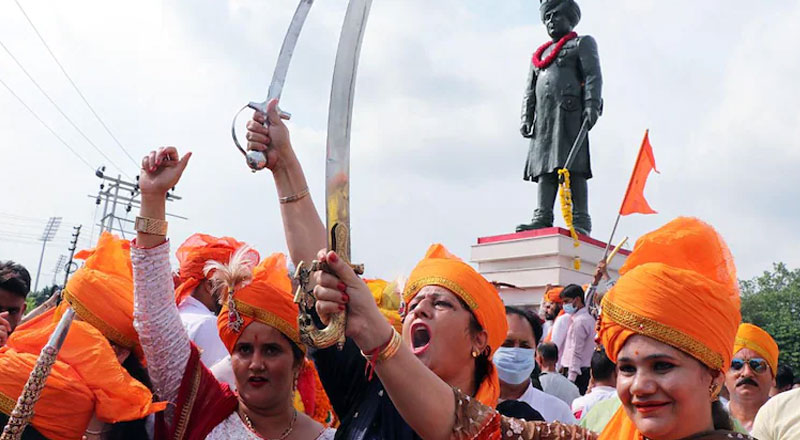While some view the trend as an attempt to ‘divide’ Hindu society, others question Rajput ‘monopoly’ over legendary kings and warriors
Leaders of some castes that have been fighting for a greater share in caste-based reservations—by citing backwardness and social discrimination—are of late increasingly laying claim to royal lineage. They are claiming legendary warriors long recognised as Rajput rulers and generals as their own. Naturally, the Rajputs are protesting and questioning why these communities should then be entitled to reservations on the basis of being from lower castes that were long discriminated against? In contrast, Sikh Rajputs, who were accorded OBC status in Punjab in 2016, have been demanding that they be placed in the General Category. They argue that the reservation status dents their glorious past and goes against their spirit of earn a living on own merit.
The issue has been rearing its head time and again. With the Akshay Kumar-starrer Prithviraj (based on the life of 12th century king Prithviraj Chauhan) set to release on June 3, members of some castes are attempting to create a controversy. The same had happened in the case of other period films about Rajput history. This time, first some Rajput groups said the king who lost to Muhammad Ghori, leading to the rule of Islamic dynasties in India, must have a Samrat honorific since he was the last recognised Hindu emperor. Soon, some Gurjar leaders demanded that Prithviraj Chauhan be described as a Gurjar and not a Rajput. They threatened to otherwise disrupt the screening of the movie.
Rajputs and Gurjars have sparred over other warriors as well. For instance, Mihir Bhoj Pratihar is a pre-medieval ruler whose dynasty is known to have kept a check on Islamic expansion in India, until Chauhan’s defeat to Ghori, and whose forces are said to have defeated Islamic rulers in Afghanistan. “It was Mihir Bhoj and his successors as well as dynasties around that era who deferred the invasion of India by Islamic rulers by nearly 300 centuries,” claims Bhanwar Singh Reta, a leader of the Jai Rajputana Sangh. “But since history books were written with the sole aim of depicting Rajputs as fighting bravely but always losing to the invaders, these victorious warriors rarely got their due.”
Gurjars claim Mihir Bhoj was born a Gurjar and have clashed with Rajputs over how his caste should be depicted on statues and memorials in various states, such as Madhya Pradesh, Haryana and Uttar Pradesh.
Other castes too are not behind. For instance, warrior Alha of Alha-Udal fame, who fought against Chauhan, is being claimed to belong to the Ahir community. Similarly, the Rajbhar community has for long laid claim over Maharaja Suheldev while some tribal leaders now say that Rana Punja, a prominent general of Maharana Pratap, was from their caste.
Mahaveer Singh Sarwari, a patron of the Pratap Foundation and a prominent Kshatriya voice in Rajasthan, alleges a political conspiracy to divide Hindus by targeting Rajput icons. “Some leaders from other castes are describing Prithviraj Chauhan, Mihir Bhoj Pratihar, Suheldev and Rana Punja as not being Rajputs. These claims are without any basis and intended to spread falsehood,” says Sarwari. He adds that since these castes claim to belong to warrior clans, they should be willing to give up caste-based reservations. Ironically, in Rajasthan, Gurjars, who are OBCs, have been demanding that they be designated lower in the caste hierarchy and be given tribal status.
he descendants of most of these icons, over whom a tug of war has ensued, are coming out in the open against what they term as distortion of Rajput history. Arunoday Singh Parihar Nagod, prince of the erstwhile Nagod state in Madhya Pradesh, wrote to Prime Minister Narendra Modi in September last year against attempts to label Mihir Bhoj Pratihar as a Gurjar. In March this year, the Panarwa royals wrote to the PM to protest against the depiction of Rana Punja as a Bhil. The direct descendants of Prithviraj Chauhan too are upset over the claims of Gurjars over the warrior king. In fact, most descendants of these legendary warriors have been following Rajput customs and marrying within Rajput clans.
ome say that it was the BJP’s strategy to give prominence to little-known but prominent folk heroes that has generated a lot of interest in leaders of various castes. In February 2021, PM Modi had virtually inaugurated a medical college named after Suheldev and laid the foundation stone of his memorial in Baharaich in Uttar Pradesh.
“All such icons have extensive recorded genealogy. All Hindus know it well that the Rajputs were a warrior and ruling class,” says the Jai Rajputana Sangh’s Reta. Hindus even have their family trees scripted from Lord Rama, Krishna and Bharat. Diya Kumari, BJP MP and a member of the Jaipur royal family, has in the past claimed that her family was a direct descendant of Rama.
RSS leaders INDIA TODAY spoke to see the trend of ‘usurping’ Rajput icons as an attempt to divide Hindu society. An RSS leader alleged that since the BJP and the Sangh are working towards a casteless Hindu society, the Congress and Left parties were fuelling these trends to push various castes into fighting with one another over community icons. However, some Rajput leaders feel that the BJP and RSS have not taken a stand in support of the Rajputs out of fear of losing vote banks among other castes. Rather, Kshatriya, a synonym for Rajputs for long, is now being expanded to include every courageous person, they say. At the same time, a prominent Left leader, speaking on condition of anonymity, insists that lower castes are doing the right thing by demolishing Rajput ‘monopoly’ over such warriors.





